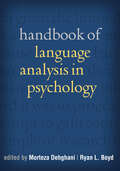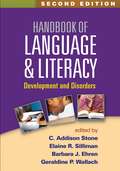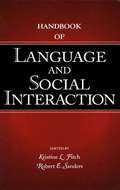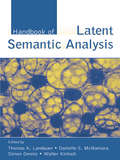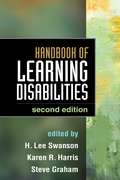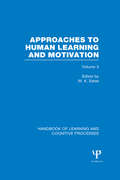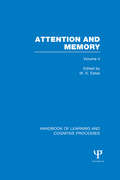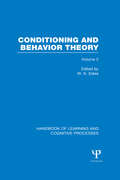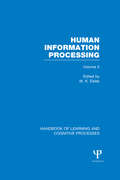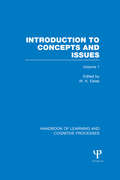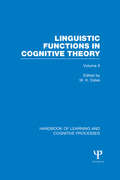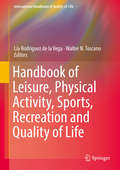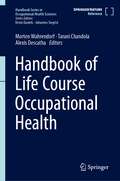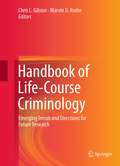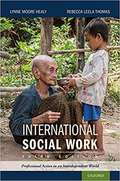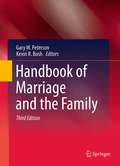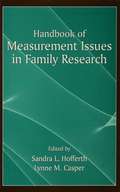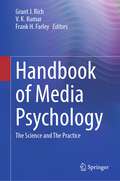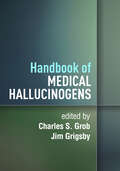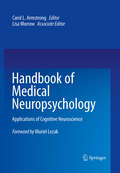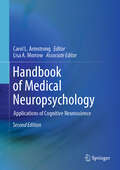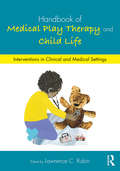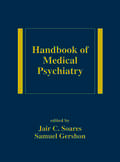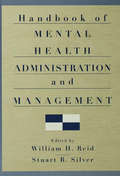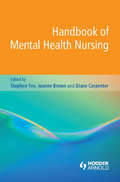- Table View
- List View
Handbook of Language Analysis in Psychology
by Morteza Dehghani and Ryan L. BoydRecent years have seen an explosion of interest in the use of computerized text analysis methods to address basic psychological questions. This comprehensive handbook brings together leading language analysis scholars to present foundational concepts and methods for investigating human thought, feeling, and behavior using language. Contributors work toward integrating psychological science and theory with natural language processing (NLP) and machine learning. Ethical issues in working with natural language datasets are discussed in depth. The volume showcases NLP-driven techniques and applications in areas including interpersonal relationships, personality, morality, deception, social biases, political psychology, psychopathology, and public health.
Handbook of Language and Literacy, Second Edition
by Elaine R. Silliman C. Addison Stone Barbara J. Ehren Geraldine P. WallachAn acclaimed reference that fills a significant gap in the literature, this volume examines the linkages between spoken and written language development, both typical and atypical. Leading authorities address the impact of specific language-related processes on K-12 literacy learning, with attention to cognitive, neurobiological, sociocultural, and instructional issues. Approaches to achieving optimal learning outcomes with diverse students are reviewed. The volume presents research-based practices for assessing student needs and providing effective instruction in all aspects of literacy: word recognition, reading comprehension, writing, and spelling. New to This Edition *Chapters on digital literacy, disciplinary literacy, and integrative research designs. *Chapters on bilingualism, response to intervention, and English language learners. *Incorporates nearly a decade's worth of empirical and theoretical advances. *Numerous prior edition chapters have been completely rewritten.
Handbook of Language and Social Interaction (Routledge Communication Series)
by Kristine L. Fitch Robert E. SandersThis Handbook stands as the premier scholarly resource for Language and Social Interaction (LSI) subject matter and research, giving visibility and definition to this area of study and establishing a benchmark for the current state of scholarship. The Handbook identifies the five main subdisciplinary areas that make up LSI--language pragmatics, conversation analysis, language and social psychology, discourse analysis, and the ethnography of communication. One section of the volume is devoted to each area, providing a forum for a variety of authoritative voices to provide their respective views on the central concerns, research programs, and main findings of each area, and to articulate the present or emergent issues and directions. A sixth section addresses LSI in the context of broadcast media and the Internet. This volume's distinguished authors and original content contribute significantly to the advancement of LSI scholarship, circumscribing and clarifying the interrelationships among the questions, findings, and methods across LSI's subdisciplinary areas. Readers will come away richer in their understanding of the variety and depth of ways the intricacies of language and social interaction are revealed. As an essential scholarly resource, this Handbook is required reading for scholars, researchers, and graduate students in language and social interaction, and it is destined to have a broad influence on future LSI study and research.
Handbook of Latent Semantic Analysis (University Of Colorado Institute Of Cognitive Science Ser.)
by Walter Kintsch Danielle S. McNamara Thomas K. Landauer Simon DennisThe Handbook of Latent Semantic Analysis is the authoritative reference for the theory behind Latent Semantic Analysis (LSA), a burgeoning mathematical method used to analyze how words make meaning, with the desired outcome to program machines to understand human commands via natural language rather than strict programming protocols. The first book
Handbook of Learning Disabilities, Second Edition
by Steve Graham Karen R. Harris H. Lee SwansonWidely regarded as the standard reference in the field, this comprehensive handbook presents state-of-the-art knowledge about the nature and classification of learning disabilities (LD), their causes, and how individuals with these difficulties can be identified and helped to succeed. Best practices are described for supporting student performance in language arts, math, and other content areas. Contributors also identify general principles of effective instruction and review issues in service delivery within response-to-intervention (RTI) frameworks. The book critically examines the concepts and methods that guide LD research and highlights important directions for future investigation. New to This Edition: *Incorporates key advances in identifying and remediating LD, with particular attention to the role of RTI. *Chapters on social cognitive, behavioral genetic, and neurobiological aspects. *Chapters on adolescents and adults with LD. *Chapters on spelling instruction, history instruction, and classroom technology applications. *Chapter synthesizing 21st-century advances in LD research methods, plus chapters on advanced statistical models, single-case designs, and meta-analysis.
Handbook of Learning and Cognitive Processes: Approaches to Human Learning and Motivation (Handbook of Learning and Cognitive Processes)
by W. K. EstesOriginally published in 1976, Volume 3 of this Handbook deals primarily with conditions of acquisition, retention and forgetting, and the manner in which acquired information and motivation combine to determine performance. The organization of this volume can be understood in terms of four principal categories. The first category deals with general problems of methodology, the second and third with basic concepts arising from research on human learning and performance and the fourth with applications. Volume 1 presented an overview of the field and introduced principal theoretical and methodological issues that persistently recurred in the expanded treatment of specific research areas which comprise the later volumes. The areas traditionally associated with conditioning, learning theory and the basic psychology of human learning are treated in Volumes 2 and 3. The last three volumes will range over active lines of research having to do with human cognitive processes, at the time: Volume 4, attention, memory storage and retrieval; Volumes 5 and 6, information processing, reading, semantic memory, and problem solving.
Handbook of Learning and Cognitive Processes: Attention and Memory (Handbook of Learning and Cognitive Processes)
by W. K. EstesOriginally published in 1976, this is Volume 4 of a series that reflected the current state of the field at the time. In this title the focus shifts to modern developments in cognitive psychology. The emphasis is primarily on attention and short-term memory, as these concepts came to be understood in the decade leading up to publication. In addition to presenting the major concepts, the authors outline fundamental theories and methods, all in a way that will be readable by anyone with a reasonable scientific background. As the editor notes in the Foreword, each author "has taken on the assignment of giving explicit attention to the orienting attitudes and long-term goals that tend to shape the overall course of research in his field and to bring out both actual and potential influences and implications with respect to other aspects of the discipline." This volume, as all volumes of the Handbook, will be invaluable for those who want an organized picture of the current state of the field as it was at the time.
Handbook of Learning and Cognitive Processes: Conditioning and Behavior Theory (Handbook of Learning and Cognitive Processes)
by W. K. EstesOriginally published in 1975, Volume 2 of this Handbook looks at areas traditionally associated with learning theory such as conditioning, discrimination and behavior theory. It deals with concepts and theories growing principally out of laboratory studies of conditioning and learning. The intention was to treat mechanisms, processes, and principles of some generality – applicable at least to all vertebrates. It was becoming well understood that detailed interpretations of particular behaviors required the authors to take account of the way general principles operate in the context of species-specific behavioral organizations and developmental histories; but detailed consideration of just how these interpretations were accomplished for different animal forms was another enterprise. Here the authors limit their task to abstracting from the enormous literature facts and ideas which seemed general enough to be of interest and perhaps utility to investigators in other disciplines at the time. Volume 1 presented an overview of the field and introduced the principal theoretical and methodological issues that persistently recurred in the expanded treatments of specific research areas that comprise the later volumes. Volume 3 looks at human learning and motivation, while the last 3 volumes range over the many active lines of research identified with human cognitive processes at the time.
Handbook of Learning and Cognitive Processes: Human Information Processing (Handbook of Learning and Cognitive Processes)
by W. K. EstesOriginally published in 1978 Volume 5 of this Handbook reflects a single theoretical orientation, that characterized by the term human information processing in the literature at the time, but which ranges over a very broad spectrum of cognitive activities. The first two chapters give some overall picture of the background, goals, method, and limitations of the information-processing approach. The remaining chapters treat in detail some principal areas of application – visual processing, mental chronometry, representation of spatial information in memory, problem solving, and the theory of instruction. The first three volumes of the Handbook presented an overview of the field, followed by treatments of conditioning, behavior theory, and human learning and retention. With the fourth volume, the focus of attention shifted from the domain of learning theory to that of cognitive psychology.
Handbook of Learning and Cognitive Processes: Introduction to Concepts and Issues (Handbook of Learning and Cognitive Processes)
by W. K. EstesFrom the Foreword: "Is it possible at present to identify a core cluster of theoretical ideas, concepts, and methods with which everyone working in the area of learning and cognition needs to be familiar? Would it be possible to make explicit the relationships that we feel do or must exist among the various subspecialties, ranging from conditioning through perceptual learning and memory to psycholinguistics, and to present these in a sufficiently organized way to help specialists and non-specialists alike in relating particular lines of research to the broader spectrum of activity? These questions were posed to a substantial number of investigators who are currently most active in developing the ideas and doing the research. Their response constitutes this Handbook…" First published in 1975, Volume 1 of this Handbook attempts to present an overview of the field and to introduce the principal theoretical and methodological issues that will persistently recur in the expanded treatments of specific research areas that comprise the later volumes. Deferring to the current Zeitgeist rather than to chronology, they begin with the present state of cognitive psychology, then introduce the comparative approach, and conclude this volume with a rapid, three-chapter review of the evolution of ideas from conditioning to information processing.
Handbook of Learning and Cognitive Processes: Linguistic Functions in Cognitive Theory (Handbook of Learning and Cognitive Processes)
by W. K. EstesOriginally published in 1978, Volume 6 concludes the survey of research and theory on learning and cognitive processes that was envisaged when the plan for this Handbook was sketched. The primary orientation in the planning the Handbook was to concentrate on research and models aimed toward the development of general cognitive theory. The first five chapters of this volume are organized in relation to one of the research areas that had expanded most vigorously during the period of planning and writing of the Handbook. These chapters treat aspects of psycholinguistics most closely related to research and theory covered in the other volumes. Perhaps the most fertile source of new concepts and models closely related to other branches of cognitive theory has been research on semantic memory. This work is given a critical review and interpretation by Smith in the first chapter of this volume, following which some lines of theoretical developmental leading "upward" into problems of comprehension of meaningful material are reviewed by Kintsch, then connections "downward" into more elementary problems of coding in memory by Johnson. Also, Johnson’s chapter shades into the very active current body of work on perceptual and memorial processes in reading, carried further by Baron’s examination of perceptual learning in relation to letter and word recognition. Finally, we consider inputs to the psycholinguistic system via speech and speech perception. The strong emphasis of Pisoni’s chapter on speech perception rather than production simply reflects both the predominance of research on perceptual aspects of speech in the current cognitive literature and the close relationships of this research to other lines of investigation of perception and short-term memory. Some knowledge of the history of the subject and some understanding of the way some of the more persuasive concepts and principles have evolved may serve present-day investigators better than boosting their reading rates. The final chapter of the present volume provides some documentation for this last suggestion.
Handbook of Leisure, Physical Activity, Sports, Recreation and Quality of Life (International Handbooks Of Quality-of-life Ser.)
by Lía Rodriguez de la Vega Walter N. ToscanoThis handbook provides an overview and synthesis of relevant literature related to leisure and recreation, and physical activity and its relationship to quality of life. Divided into two parts, the text presents the analysis of leisure and recreation studies and physical activities and sports, with diverse populations. The first part deals with leisure and recreation in relation to quality of life, with different perspectives on different age groups, ethnic groups, the approach of an Integrated Model of Leisure Well-being focusing on how leisure activities contribute to leisure well-being etc. The second part deals with physical activities and sports in relation to quality of life, discussing the consideration that "exercise is good for you", associating physical exercise with other conditions of life in society, its impact on people with disabilities, etc. It is of interest to researchers and students, legislators, educators, providers of leisure services.
Handbook of Life Course Occupational Health (Handbook Series in Occupational Health Sciences)
by Morten Wahrendorf Tarani Chandola Alexis DescathaThis handbook provides a comprehensive overview of recent developments in research on the relationship between occupational trajectories over the life course and health. It uncovers the impact of far-reaching changes of work and employment, as evidenced by increased flexibility, discontinuity, and technological innovation, and offers insights into recent theoretical and methodological developments addressing this challenge. In its main parts, it presents the best evidence to readers about the following topics: early life influences on (un)healthy work, chronic exposure to occupational risks; nonstandard employment and poor health; work continuation with chronic disease; occupational determinants of healthy aging. In its final part, it discusses policy implications of current knowledge and points to the need of developing new solutions in research and practice, not least in times of climate crisis and the new pandemic.The important handbook has been prepared by a distinguished editorial team, with chapters written by prominent international experts. Despite its continuous reference to scientific knowledge it addresses its content to a broader, non-specialized readership.
Handbook of Life-Course Criminology
by Marvin D. Krohn Chris L. GibsonThe wide-ranging scope of the Handbook of Life-Course Criminology covers genetics and environment, child offenders and late bloomers, the impact of school and peers, lifelong and time-limited criminal careers, and qualitative and quantitative methodologies. This unique Handbook is further set apart by its dual coverage of the leading edge of current research and innovative directions for future work in the field. Pathways to crime have been a central concept of criminology from its inception. Accordingly, a lifespan approach to the field has replaced earlier biological and sociological perspectives with a more nuanced understanding of offender behavior and a wider lens of study. The contributions to this Handbook break down issues of criminal and antisocial behavior from early childhood to late adulthood, examining developmentally targeted prevention and intervention strategies and reviewing emerging trends in research. Among the topics: · Childhood: including physical aggression in childhood, pre- and peri-natal development, and environment. · Adolescence: the impact of schooling, unstructured time with peers, gang membership and peer networks. · Adulthood: Adult onset crime, unemployment in emerging adulthood, crime and adult outcomes. · Prevention and Intervention: community programs, lifetime intervention strategies, re-entry. This volume will be a valuable piece for researchers in Criminology and Criminal Justice as well as related disciplines such as Sociology, Developmental Psychology, and Social Policy. It will serve as an important reference for the current state of research, as well as a roadmap for future scholars. -- "This impressive Handbook provides comprehensive coverage of key developmental and life course issues in criminology from birth to adulthood, including biology, genetics, gangs, schools, neighborhoods, adult onset, desistance, and interventions. The research recommendations in each chapter are especially important, and they should stimulate advances in knowledge for many years to come. This Handbook should be required reading for all criminologists." David P. Farrington, Professor of Psychological Criminology, Cambridge University, Cambridge, UK "In just a few decades developmental criminology has become the dominant intellectual force in criminology. This volume demonstrates why. It provides incisive reviews of important themes in developmental criminology. More importantly, it lays out rich agendas for future research that should inspire the next generation of developmental criminologists." Daniel S. Nagin, Teresa and H. John Heinz III University Professor of Public Policy and Statistics, Carnegie Melon University, Pittsburgh, PA, USA
Handbook of Life-Span Development
by Karen L. Fingerman Jacqui Smith Cynthia A. Berg Toni C. AntonucciThe doubling of our average life span since the turn of the 20th century is considered by many scholars to be one of the most important changes in human existence. This definitive text is the only volume to fully address, through a multidisciplinary perspective, the biological, cognitive, and psychological development that occurs from infancy through old age, and how the sociocultural and institutional factors interface with these changes. <p><p> Edited by leading research scholars in the field of life-span development, the volume also includes contributions of specialists in behavioral genetics, socioemotional selectivity theory, neuroscience, ecological models, and more. It examines the dynamics of close relationships and informal ties among the elderly population, child-parent attachment relationships as a life-span phenomenon, developmental tasks across the lifespan, continuity and discontinuity in temperament and personality, the sociocultural context of cognition across the life span, and variability in approaches to social problem solving from early to later life. Given the number of recent demographic shifts, it also explores issues related to fertility, life expectancy, environmental contexts, technology, immigration, and public policy.
Handbook of Marriage and the Family
by Gary W. Peterson Kevin R. BushThe third edition of Handbook of Marriage and the Family describes, analyzes, synthesizes, and critiques the current research and theory about family relationships, family structural variations, and the role of families in society. This updated Handbook provides the most comprehensive state-of-the art assessment of the existing knowledge of family life, with particular attention to variations due to gender, socioeconomic, race, ethnic, cultural, and life-style diversity. The Handbook also aims to provide the best synthesis of our existing scholarship on families that will be a primary source for scholars and professionals but also serve as the primary graduate text for graduate courses on family relationships and the roles of families in society. In addition, the involvement of chapter authors from a variety of fields including family psychology, family sociology, child development, family studies, public health, and family therapy, gives the Handbook a multidisciplinary and interdisciplinary framework.
Handbook of Measurement Issues in Family Research
by Sandra L. Hofferth Lynne M. CasperDramatic societal changes have reshaped America’s families. Young adults have delayed marriage, and cohabitation before marriage has become commonplace. One in three women giving birth is unmarried, and the proportion of children under 18 living in single-parent families rose from 23 to 31 percent between 1980 and 2000, reflecting increased rates of both nonmarital childbearing and divorce. This authoritative volume offers a blueprint for addressing some of the most important measurement issues in family research, and it points out potential pitfalls for researchers and students who may not be familiar with data quality issues. The Handbook of Measurement Issues in Family Research will appeal to scholars in the departments of psychology, sociology, and population studies, as well as researchers working in governmental agencies.
Handbook of Media Psychology: The Science and The Practice
by Grant J. Rich V. K. Kumar Frank H. FarleyThis comprehensive and up-to-date resource presents the state of the science in the expanding and widely influential field of media psychology and technology. Covering theoretical concepts, research, and practice, this handbook explores key areas relevant to developing media psychology and technology in today's world.The impact of media and technology is discussed as are the uses and misuses of various media outlets, including television, film, and social media. How media affects public opinion and attitudes is given special attention, as are psycho-social and neuropsychological factors. The authors are recognized experts in this field, many associated with the American Psychological Association’s Society of Media Psychology and Technology. This relevant and timely handbook provides researchers and academics with rich wide-ranging presentations of an area critical to the dissemination and discussion of results and implications of ongoing scientific investigations for bringingabout social change in democratic societies through the use of media and technology.
Handbook of Medical Hallucinogens
by Charles S. Grob and Jim GrigsbyThis handbook reviews promising applications of psychedelics in treatment of such challenging psychiatric problems as posttraumatic stress disorder, major depression, substance use disorders, and end-of-life anxiety. Experts from multiple disciplines synthesize current knowledge on psilocybin, MDMA, ketamine, and other medical hallucinogens. The volume comprehensively examines these substances' neurobiological mechanisms, clinical effects, therapeutic potential, risks, and anthropological and historical contexts. Coverage ranges from basic science to practical clinical considerations, including patient screening and selection, dosages and routes of administration, how psychedelic-assisted sessions are structured and conducted, and management of adverse reactions.
Handbook of Medical Neuropsychology
by Carol L. Armstrong Lisa MorrowThe recent surge of interest in the neuroscience of autism, HIV/AIDS, cancer, Alzheimer's, and other disorders has brought with it an increasing awareness of the effects of medical conditions on the brain and behavior--an awareness extending through the research and practice arenas, among those working with pediatric and adult clients alike. Comprehensive in scope and highly detailed in its coverage, the Handbook of Medical Neuropsychology is organized to give readers knowledge of the field, whether one needs to understand a clinical evaluation, design a research study, or gain a deeper understanding of disease processes and corresponding behaviors. Featuring the most up-to-date information on cognitive neuroscience to enhance the work of the practitioner, the student, or the researcher, the book handles theory, historical background, practical considerations, and controversial areas with clear explanations, clinical expertise, and real-world insight, and critiques diagnostic and assessment tools specific to disorders. The wide selection of commonly seen and rarely encountered diagnoses covered includes: Primary nervous system disease and injury. Vascular system disease. Developmental, genetic, and structural disorders. Dementia and normal aging. Immune-related disorders. Endocrine disease. Metabolic conditions. Plus a chapter on current and emerging approaches to rehabilitation. Opening out a specialty as it grows in importance, the Handbook of Medical Neuropsychology is an essential resource for the neuropsychology clinician, researcher, or graduate student.
Handbook of Medical Neuropsychology: Applications Of Cognitive Neuroscience
by Lisa Morrow Carol ArmstrongThis handbook celebrates the abundantly productive interaction of neuropsychology and medicine. This interaction can be found in both clinical settings and research l- oratories, often between research teams and clinical practitioners. It accounts for the rapidity with which awareness and understanding of the neuropsychological com- nents of many common medical disorders have recently advanced. The introduction of neuropsychology into practice and research involving conditions without obvious neurological components follows older and eminently successful models of integrated care and treatment of the classical brain disorders. In the last 50 years, with the growing understanding of neurological disorders, neuropsychologists and medical specialists in clinics, at bedside, and in laboratories together have contributed to important clinical and scienti c advances in the und- standing of the common pathological conditions of the brain: stroke, trauma, epilepsy, certain movement disorders, tumor, toxic conditions (mostly alcohol-related), and degenerative brain diseases. It is not surprising that these seven pathological con- tions were the rst to receive attention from neuropsychologists as their behavioral symptoms can be both prominent and debilitating, often with serious social and economic consequences.
Handbook of Medical Play Therapy and Child Life: Interventions in Clinical and Medical Settings
by Lawrence C. RubinThe Handbook of Medical Play Therapy and Child Life brings together the voices and clinical experiences of dedicated clinical practitioners in the fields of play therapy and child life. This volume offers fresh insights and up to date research in the use of play with children, adolescents, and families in medical and healthcare settings. Chapters take a strength-based approach to clinical interventions across a wide range of health-related issues, including autism, trauma, routine medical care, pending surgeries both large and small, injury, immune deficiency, and more. Through its focus on the resiliency of the child, the power of play, and creative approaches to healing, this handbook makes visible the growing overlap and collaboration between the disciplines of play therapy and child life.
Handbook of Medical Psychiatry
by Samuel Gershon Jair C. SoaresThis volume examines attempts to identify genetic risk factors and environmental components contributing to the development of psychiatric disorders. It explores the symptoms, courses, outcomes, treatment responses and aetiologies of a range of psychiatric illnesses to improve disease classification schemes.
Handbook of Mental Health Administration and Management
by Mph William H. Reid Stuart B. SilverClinicians who understand mental health care administration in addition to their clinical fields are likely to be valuable to the organizations in which they work. This handbook is an accessible source of information for professionals coming from either clinical or management backgrounds. Sections offer coverage in: mental health administrative principles, mental health care management, business, finance and funding of care, information technology, human resources and legal issues.
Handbook of Mental Health Nursing
by Diane Carpenter Joanne Brown Stephen TeeA concise and user-friendly guide, Handbook of Mental Health Nursing helps nursing students learn the essential skills required for practice. This practical handbook is informed by an interdisciplinary understanding of mental health problems and the recovery from mental health difficulties. Features:Highlights case studies and draws on narrati
